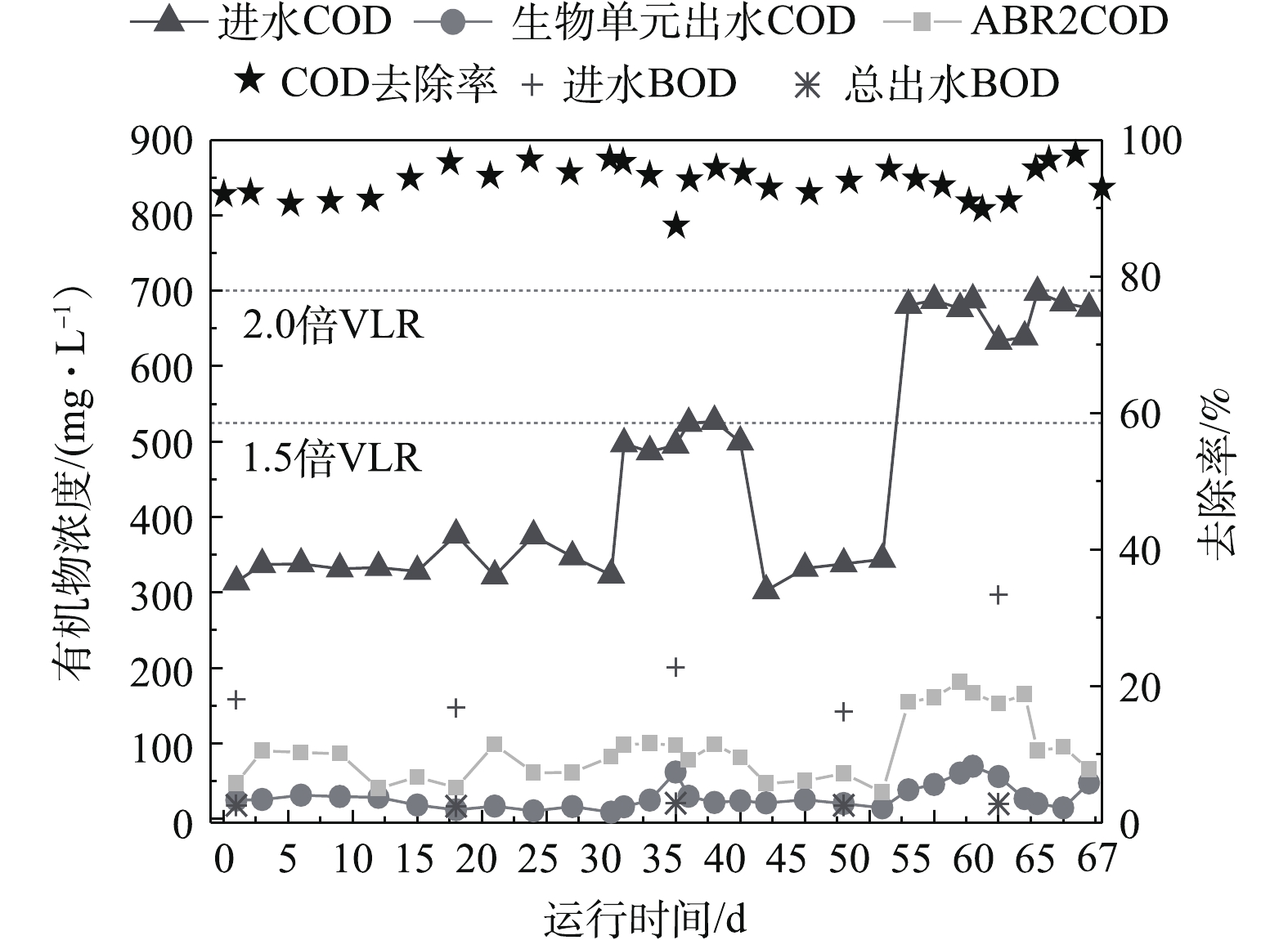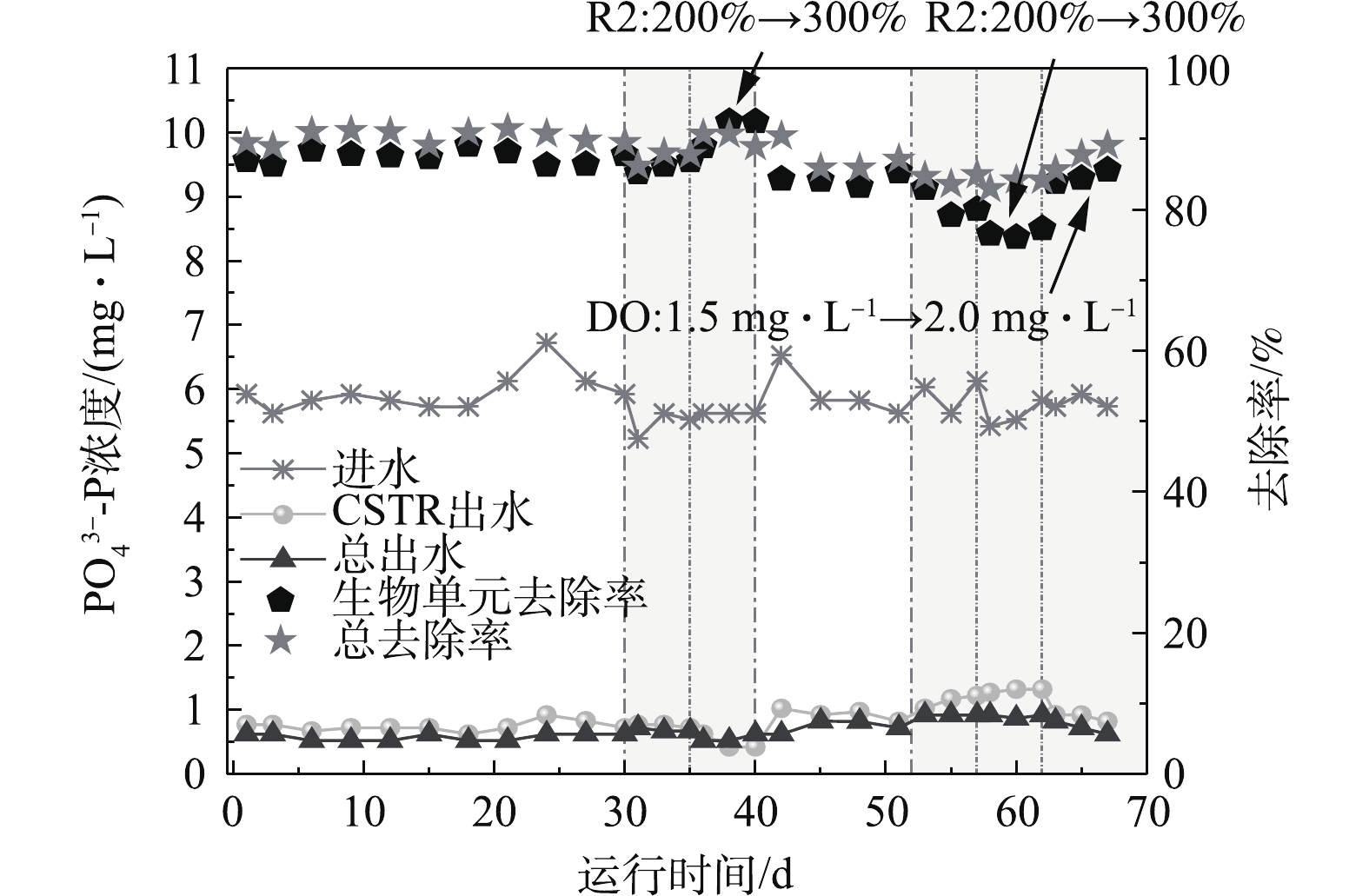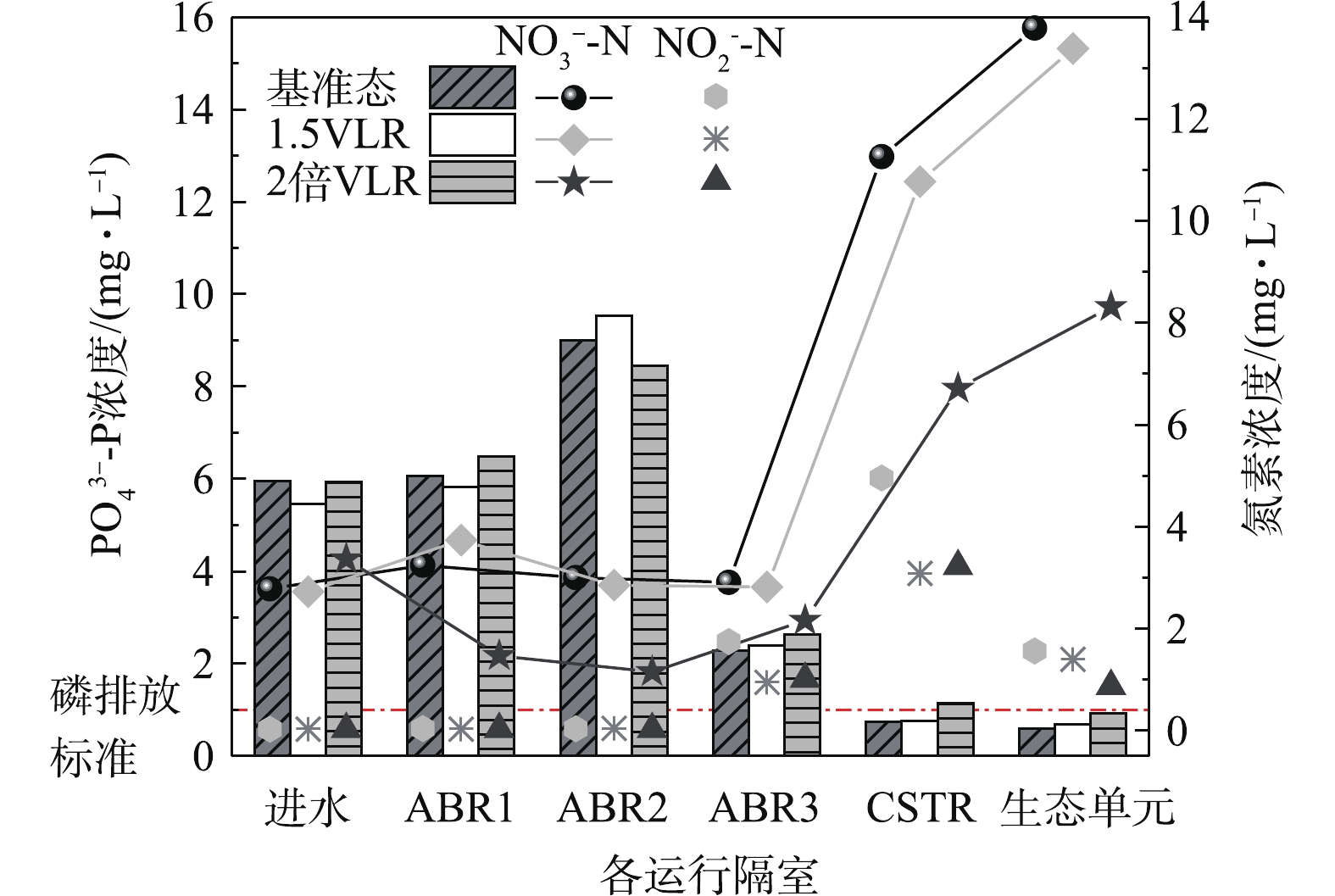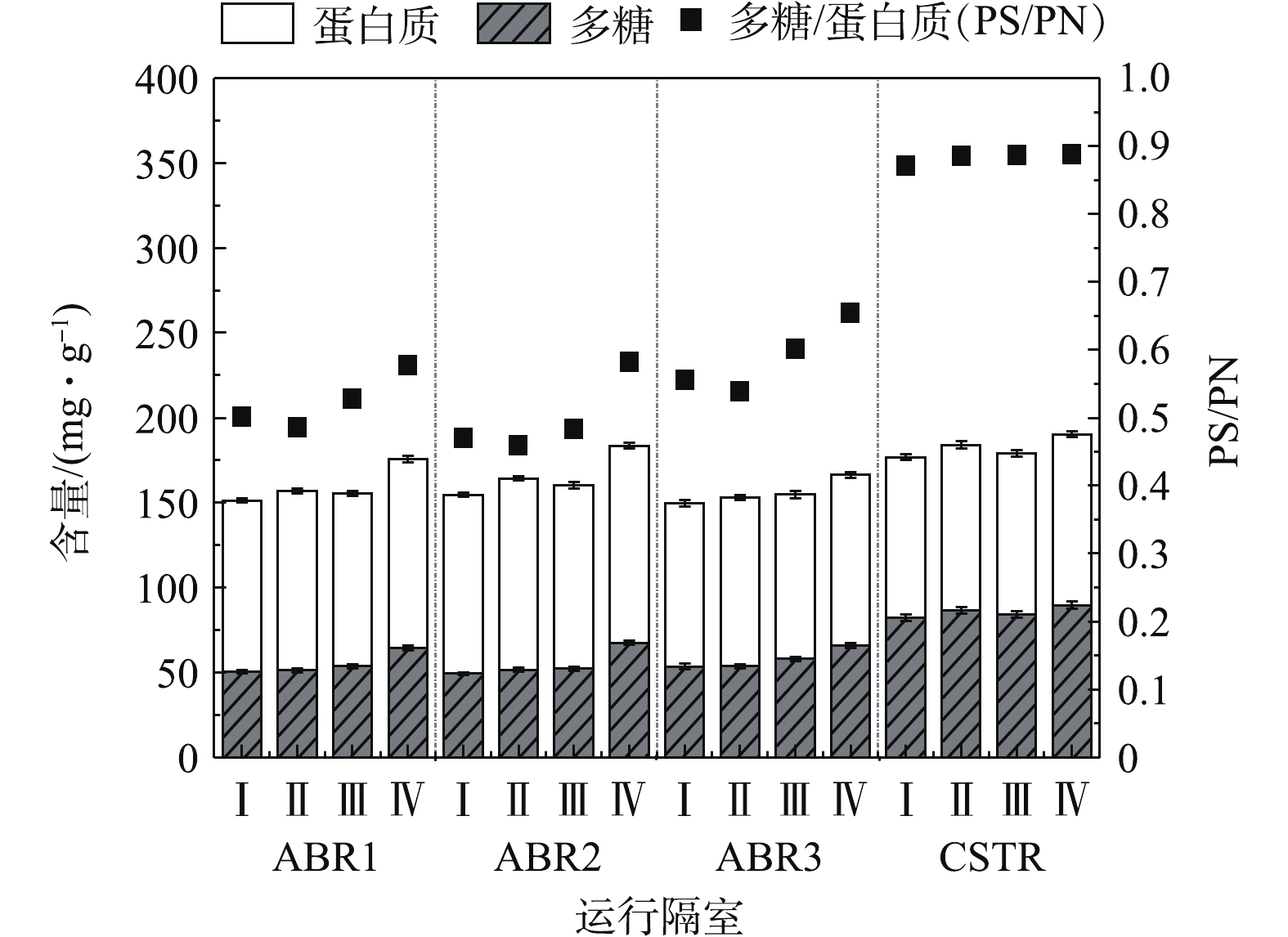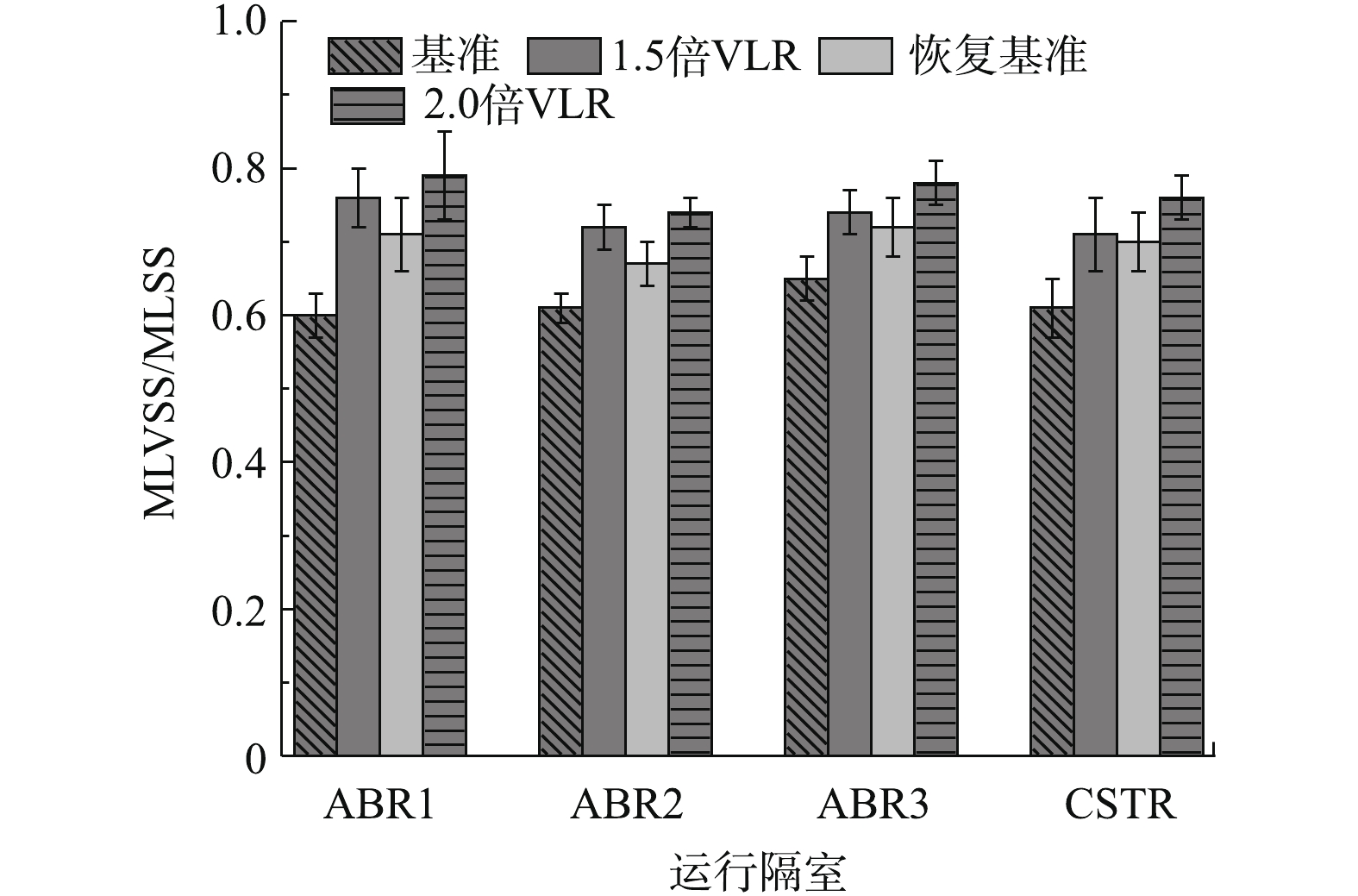-
船舶运输往来推动经济高速发展和人民生活质量的提升,但同时其生活污水排放不可避免地会造成水体污染,若近海及河道的船舶产生的生活污水处理不当,将影响内河、湖泊、水库等与人类生活息息相关的用水水质[1-2]。船舶相对城镇来说,具有人口集中、占地面积小的特点,因而生活污水水质短期波动大、碳氮负荷、TSS高[3]。目前存在的船舶生活污水处理装置多与常规市政污水处理一致[4],处理深度和稳定性存有不足,亦易忽略节能和美观需求[5]。船舶人口集中,污水处理装置须面对短期有机负荷的冲击,同时针对船舶生活污水碳氮磷排放的新标准[6],须迫切寻求高效稳定、节能美观的船舶生活污水处理装置。
考虑治理要求和环保发展前景,可应用反硝化除磷(denitrifying phosphorus removal,DNPR)高效生物脱氮除磷技术的厌氧折流板反应器(ABR)-连续流搅拌槽式反应器(CSTR)连续流组合工艺与生态法耦合联用装置处理船舶污水。ABR-CSTR较序批式工艺在实际应用中更稳定可控,各功能菌能于各自生长适宜条件下成为优势菌种,ABR可生物相分离,生成优质碳源[7],使反硝化聚磷菌(denitrifying phosphorus accumulating organisms,DPAOs)的富集和增殖更易实现;CSTR通过完全混合培养硝化菌,与膜生物反应器(MBR)相比,具有成本低且污染小的特点,更适合船舶生活污水治理。ABR-CSTR组合工艺通过污泥回流和硝化液回流实现DNPR,在厌氧条件下,DPAOs分解多聚磷酸盐产生能量(ATP),同时挥发性脂肪酸(VFA)在质子推动力(PMF)下进入胞内合成聚羟基烷酸(PHA)[8];缺氧时分解PHA生成乙酰辅酶A进行三羧酸(TCA)循环,产生ATP用于过量吸磷合成体内聚磷,同时反硝化
NO−x -N,实现碳源同时脱氮除磷[9],大幅降低氧和碳源需求,节约运行成本[10-11]。生物单元出水流经末端由水生植物、鱼类、微生物和基质共同组成的生态单元后排出,从外观看,动植物构成的生态景观较传统处理工艺更具美感;同时,植物本身的吸附作用及其根系附着的微生物可强化降解污染物,对水质波动起缓冲作用,绿色技术的融入可改善装置能源渠道。综合船舶生活污水水质波动的现状,基于1.2 kg·(m3·d)−1ABR进水容积负荷(VLR)、COD值为350 mg·L−1的稳定运行条件,模拟1.5倍和2.0倍VLR的短期冲击。有机负荷冲击会影响处理效能,主要体现在污染物去除率和生物质表面及内部的特征变化[12]。碳源量影响聚磷菌(PAOs)和聚糖菌(GAOs)的生长繁殖,GAOs的增多可抑制除磷效果[13]。有机底物浓度较高时,微生物会分泌更多的胞外聚合物(EPS)来抵御不利条件[14-15],因此,观察污泥特性变化有助于深入探究处理效能。本研究模拟船舶生活污水短期有机冲击负荷,从系统高效去碳脱氮除磷的性能和污泥特性的变化方面,考察了ABR-CSTR-生态单元一体化反应装置的运行情况,同时通过调整运行工况获得了应对波动的稳定策略。结果表明,在不同冲击下,末端生态单元确保系统具有抗波动的稳定性,使装置在高效处理船舶生活污水的同时提供景观价值,可为生活污水治理领域提供新思路和理论支持。
全文HTML
-
ABR-CSTR-生态单元一体化反应装置见图1,生态单元内置3隔室ABR-CSTR组合反应器。生态单元、ABR、CSTR反应区和沉淀区有效容积分别为27、5.4、2.7和1.8 L,ABR1、ABR2为厌氧区域,ABR3通过CSTR内硝化液回流(R2)构成缺氧环境,ABR3污泥回流(R1)至ABR2,使DPAOs历经含氧环境循环实现除磷。生态缸水深为35 cm,底部基质为天然亚热带酸性肥沃黑土所制的水草泥,厚度为5 cm,按底面积适宜密度栽培6株常见水生植物皇冠草(Echinodorus amazonicus),投放美观、生长力佳的金鲫鱼,水浴温度维持在27~28 ℃。
-
为精准控制研究条件,研究采用基于校园厕所废水优化配置的模拟进水(比例为1∶1),以C6H12O6、淀粉调配碳源,以NH4Cl、KH2PO4分别调配氮、磷源,使氮和磷浓度控制在55~65 mg·L−1和4~7 mg·L−1。此外,加入CaCl2、MgSO4·7H2O等补充生物所需的常量元素,同时添加微量元素[16],为更贴近船舶生活污水,另加高岭土(50 mg·L−1)确保污水浊度,使用NaHCO3调节pH为7.5左右。
ABR-CSTR连续流反应器接种污泥来自苏州市某污水处理厂浓缩池,ABR各隔室投放至2/3处,MLSS 为21 g·L−1;CSTR内污泥参数为SVI 105.5 mL·g−1,MLSS 5 500 mg·L−1。
-
在前期研究中,ABR-CSTR-生态缸在VLR(ABR)为1.2 kg·(m3·d)−1,COD为350 mg·L−1,污泥沉淀时间为2.3 h,总HRT为12.8 h,SRT为 20 d,R1为 80%、R2 为200%的情况下稳定实现反硝化除磷,总出水COD、TP和TN去除率达到94%、81%和82%。当SS和BOD值低于20 mg·L−1和17 mg·L−1时,采用RYU等[17]的方法估算富集DPAOs占PAOs比值约为73%,此工况定为基准态。本实验设计方案如表1所示,基态运行30 d(阶段Ⅰ),保持HRT不变,通过提高进水COD值以实现1.5倍VLR(阶段Ⅱ,工况2、3)和2.0倍VLR(阶段Ⅳ,工况5、6、7)冲击,期间恢复基态运行12 d(阶段Ⅲ),阶段Ⅱ和Ⅳ每段工况运行5 d,其中将工况3和6中R2调整至300%,工况7提高DO至2.0,以此探究了应对冲击的调控策略。
-
水样经0.45 μm中速滤纸过滤,COD、BOD,
NH+4 -N、NO−2 -N、NO−3 -N、TN、TP及MLSS、MLVSS按文献中的方法[18]进行测试分析,使用HACH-HQ30d便携式测定仪检测DO,使用FiveGo F2便携酸度计测定pH。污泥特性部分取自工况1、2、4和5,采用10 mL泥水混合液以10 000 r·min−1离心10 min来提取EPS,倒掉上清液,加EPS缓冲液补充至原体积,重复离心步骤后倒掉上清液,再补充缓冲液至10 mL后,将泥水倒入锥形瓶,加0.06 mL甲醛在摇床内,180 r·min−1振荡1 h,上清液离心15 min后,使用0.22 μm滤膜过滤,此上清液即为紧密结合型胞外聚合物(TB-EPS);多糖(PS)采用苯酚-硫酸法测定,蛋白质(PN)含量使用福林酚试剂法测定。
1.1. 实验装置
1.2. 污水水质及接种污泥
1.3. 实验方案
1.4. 测定分析方法
-
1) 有机物去除情况。大部分耗氧有机污染物(以COD计)在厌氧段被消耗,经水解酸化为VFA后,以胞内聚合物PHAs储存在微生物内,因而碳源去除情况与反硝化除磷效果息息相关。不同有机冲击负荷下有机污染物的去除情况见图2,系统对有机物始终保持较好的去除效果,1.5倍和2.0倍VLR冲击下生物单元COD出水值先上升后下降,平均去除率分别为94.1%和92.6%,总出水浓度在60 mg·L−1以下。
基准态、1.5倍和2.0倍VLR冲击下,ABR前2隔室中COD去除率为82.5%、80.7%和75.8%,说明有机物在系统中得以充分转化为优质碳源VFA,而可被DPAOs释磷时利用。进入好氧段的COD值较低,可避免对硝化反应的干扰。进入ABR段,污水BOD/COD比值经水解酸化后升高,由平均值0.4升至0.65,从而进一步提升了生物降解性,好氧后出水BOD值维持在20 mg·L−1左右,总出水BOD与之持平,符合排放标准,可见高有机负荷冲击下系统对BOD的降解效果稳定。
2) 氮的去除特性。在2种有机负荷的冲击下(阶段Ⅱ和Ⅳ),氨氮去除率存在明显的波动。如图3所示,1.5倍VLR冲击时出水氨氮高于6 mg·L−1,这可能是由于面对高有机负荷时,硝化菌对外界基质变化更为敏感[19]所致,因自养菌在与异养细菌竞争氧气等生存要素时处于劣势地位,系统很快恢复氨氮去除性能,说明好氧段NOB对有机负荷变化有良好的适应力。在2种冲击下,连续流内氨氮平均去除率分别为92.7%和98.0%,生物单元出水氨氮可达到2 mg·L−1以下。
在3种负荷下,TN去除率分别为62%、67.3%和73.7%,有机负荷冲击下出水TN浓度低于18 mg·L−1和16 mg·L−1。可见随着VLR升高,有额外碳源进入CSTR反应区,使硝化段发生了同步硝化反硝化作用,TN进一步降低。在SBR和ABR-MBR连续流工艺的相关研究[20-21]中,均发现进水COD值提高对系统TN去除性能和DNB反硝化速率有显著的强化作用。生态单元可进一步吸附氨氮,保证了在连续流出水存在波动的情况下,生态单元内氨氮浓度可稳定维持于一定的水平,生态缸内
NH+4 -N浓度在生态循环作用下可比CSTR出水低2 mg·L−1,以确保装置对氨氮良好的去除效果。3) 对同步脱氮除磷的影响。不同有机冲击下生物单元除磷效果存在一定波动,系统总出水
PO3−4 -P保持在1 mg·L−1以下。如图4所示;在R2为200%、1.5倍VLR冲击下,生物单元除磷效率变化较小(由87.5%降至86.1%),除磷率最高点在1.5倍VLR;R2为300%时(工况3),可达92.5%,其浓度为0.42 mg·L−1,硝化液回流比的升高强化了DPAOs的除磷效果,吸磷量由7.10 mg·L−1升至7.41 mg·L−1。当有机负荷升高时,ABR具有进一步提高消耗耗氧有机污染物生成优质碳源的能力,生成更多的VFAs,供DPAOs在厌氧段释磷,硝化液回流比的升高使可供过量吸磷的电子受体浓度增加,缺氧吸磷更充分;在2倍有机冲击、R2为200%时(工况5),COD去除率降至76.4%;提升R2至300%,除磷率未有明显上升,此时ABR内微生物在底物浓度增加下持续增殖,而过量COD在ABR内未能消耗完全,进入CSTR的剩余碳源含量高于50 mg·L−1,影响NOB和AOB氧化氨氮。反硝化菌在碳源存在下逐渐占据优势,使硝化反应未能充分进行,此时R2的提升增加了回流液的稀释作用,但对系统反硝化除磷效果没有明显帮助。随之采用提高曝气量的策略,将DO由1.5 mg·L−1提升为2.0 mg·L−1,系统除磷效果随之升高,达84.6%。反应区内含氧量的增加抑制DNB合成体内硝酸盐还原酶,使NOB活性释放,硝化反应得以良好进行,此时提升的硝化液回流比增加了进入缺氧段的NO−x -N浓度,吸磷量由5.17 mg·L−1升至6.01 mg·L−1,在充足的电子供体下,反硝化除磷效果获得进一步提高。由图4可知,生态单元可对磷进一步降解,缸内PO3−4 -P含量稳定维持在0.5~0.95 mg·L−1,生态缸对波动具有较强的缓冲作用,当CSTR出水磷浓度在短时间内小于0.5 mg·L−1时,缸内含磷量并不会随之立即下降,而是维持在一定范围,以保证生态循环内营养元素的稳定。装置沿程
PO3−4 -P和氮素浓度变化直接反映系统反硝化除磷效果。图5反映了不同有机冲击下,R2=200%时系统各隔室氮磷浓度的变化。由图5可知,在1.5倍和2.0倍VLR冲击下,生物单元出水磷浓度分别为0.76 mg·L−1和1.14 mg·L−1。在1.5倍有机冲击时,ABR2中PO3−4 -P浓度有少量升高,由8.99 mg·L−1升至9.52 mg·L−1,释磷量也相应增加。这是因为在进入厌氧区的有机物浓度瞬时上升时,微生物在充足底物下刺激活性激增,ABR水解促使更多优质碳源(如VFA)生成,DPAOs在ABR2充足的ATP下合成胞内聚羟基烷酸(PHA),同时释磷,此时在电子受体NO−x -N有限的情况下,缺氧除磷量受到限制,因而系统除磷量变化较小。当有机冲击升负荷至2.0倍VLR时,释磷量出现明显下降,ABR2磷含量降至8.45 mg·L−1,此时有机浓度过高,促使ABR内的少量聚糖菌的活性增强,而GAO在消耗VFAs时并不具备除磷能力[22],使可供DPAOs释磷的优势碳源量出现不足,影响释磷。在此负荷下,缺氧吸磷量由7.13 mg·L−1降至5.82 mg·L−1,由于部分有机物进入好氧区,影响了硝化菌氧化氨氮,使硝化不完全,CSTR内的
NO−3 -N由10.78 mg·L−1降至6.71 mg·L−1,回流液中NOx−-N量减小,缺氧隔室内DPAOs进行同步脱氮除磷的电子受体不足,这是影响系统除磷效率的关键。 -
1)微生物量变化情况。MLVSS/MLSS比值意味着污泥中活性物质组分的多少[14],不同有机冲击下的结果见图6。与CHEN等[23]的研究结果一致,随着进水有机冲击负荷增加,MLVSS和MLSS均有所上升,厌氧段ABR1比值增幅最大,由0.6升至0.79。这说明该段污泥在高有机底物的促进下,微生物活性成分急剧增多。每段冲击相较其前段基准态,1.5倍VLR下各运行隔室MLVSS/MLSS比值增幅均高于2倍冲击,ABR1内分别为0.16和0.09,可能由于在高有机负荷进水下,微生物对底物的吸收存在限度,使MLVSS和MLSS生长趋势减缓。
2)对胞外聚合物(EPS)的影响。胞外聚合物(EPS)聚集在微生物表面,主要由多糖和蛋白质构成,起维持细胞体结构稳定的保护作用,随外界环境的变化而改变胞外的物化性质[24-25]。如图7所示,在有机负荷冲击下,多糖和蛋白质含量均上升,在厌氧环境尤其是ABR2隔室内EPS含量增幅明显,在1.5倍和2.0倍VLR冲击下,其由154.5 mg·g−1分别升至164.2 mg·g −1和183.4 mg·g−1,这可能由于厌氧环境下高有机负荷刺激最为剧烈,微生物需要分泌更多EPS来维持细胞的稳定生存。CSTR内微生物EPS及其组成成分变化最小,因为有机负荷在前端ABR内被大量去除,进入硝化区的冲击水平被大幅削弱,故对硝化菌结构特性影响小。多糖与蛋白质的比值(PS/PN)可反映污泥絮凝性,蛋白质占比越大,说明污泥表面疏水性越强,越利于污泥絮凝体稳定聚集;PS/PN比值越低,代表絮凝性好[26-28]。ABR内多糖与蛋白质的比值变化明显,1.5倍VLR冲击下,PS/PN最低为0.48,厌氧隔室内污泥颗粒化效果也最佳,在有机负荷冲击进一步增强下,污泥表面结构失稳,疏水性降低。此外,CSTR内PS/PN维持在0.87~0.89,这表明有机冲击对硝化段内污泥絮凝效果影响较小。
2.1. 不同冲击负荷下污染物去除情况
2.2. 污泥特性变化
-
1) ABR-CSTR-生态单元一体化反硝化除磷装置具有一定抗有机冲击能力,在1.5倍和2倍稳态进水有机负荷下,耗氧有机污染物(以COD计)平均去除率始终大于90%,总出水BOD和TN可达标排放,系统除磷效果稳定;在有机负荷为2倍基准条件下,CSTR硝化反应受干扰,供DPAOs缺氧同步脱氮除磷的电子受体不足,从而影响吸磷。
2)在一定的有机冲击下,升高硝化液回流比有助于提升反硝化除磷效果;当有机负荷进一步升高时,提高硝化液回流比对除磷提升效果甚微,增高好氧段DO可使系统缺氧吸磷量有所提升。
3)生态单元通过生态循环进一步降解氮磷,同时对水质波动具有缓冲作用,可维持生态单元内水质的稳定及水生动植物的良好生长。
4)污泥MLVSS/MLSS比值及微生物体内EPS含量随有机底物浓度的升高而上升,前者在ABR1内增幅最大;ABR2内EPS含量增加最为显著,CSTR内微生物EPS含量最多,但其成分变化最小,在有机冲击下,厌氧隔室多糖/蛋白质比值可达最低,此时污泥絮凝性最佳。





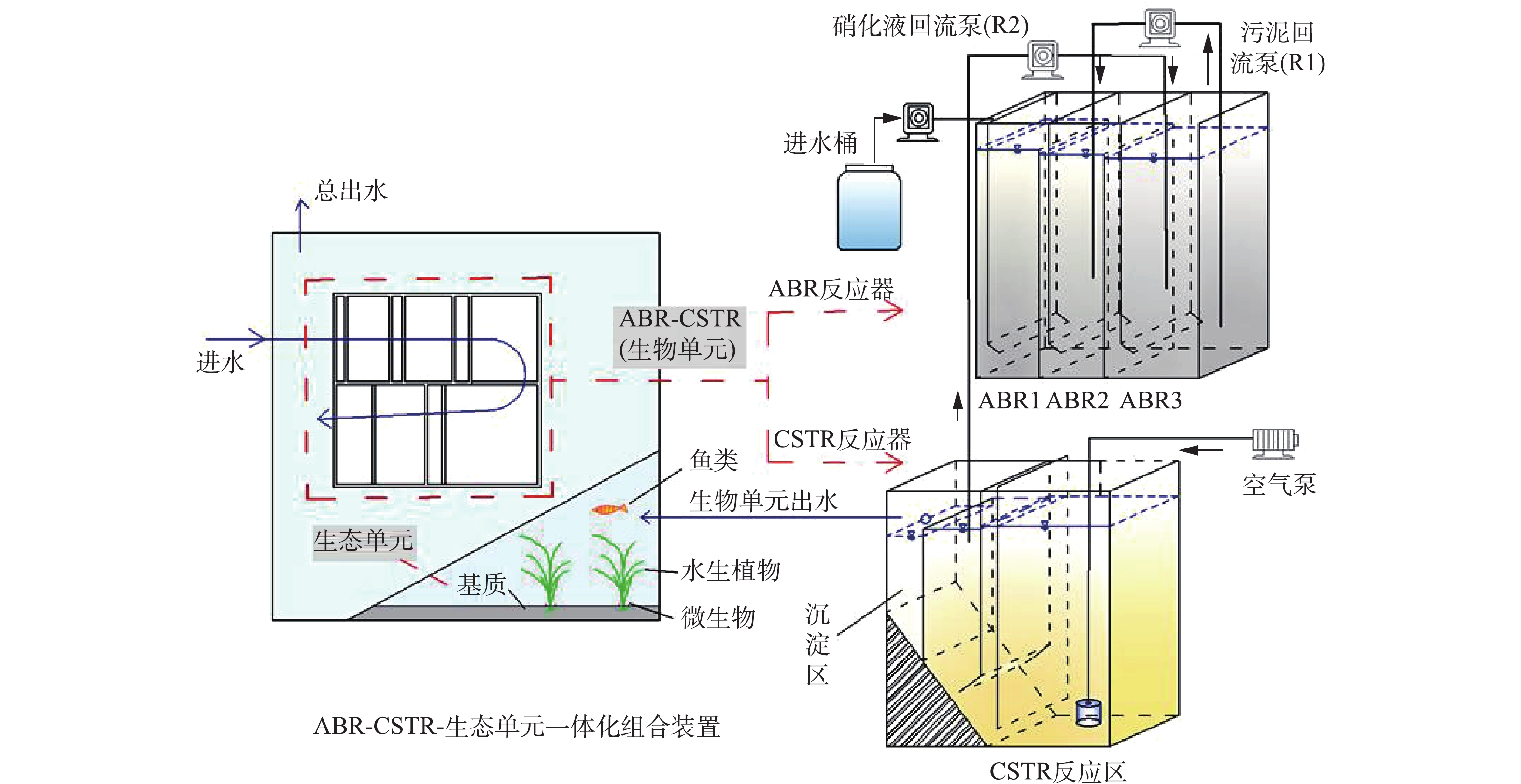
 下载:
下载:
